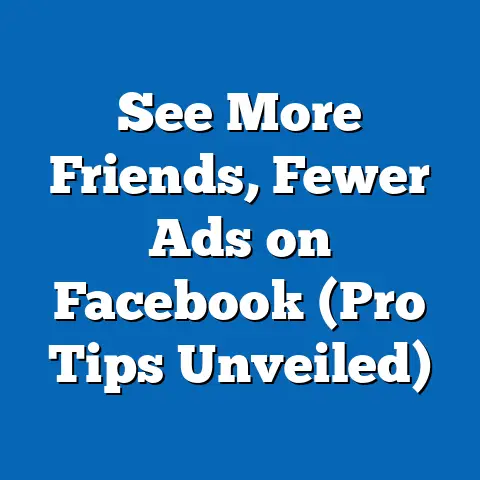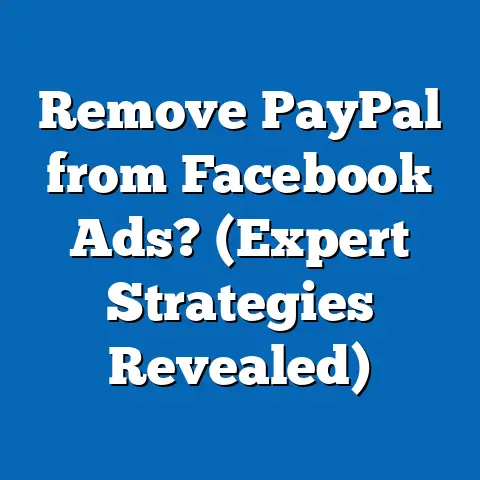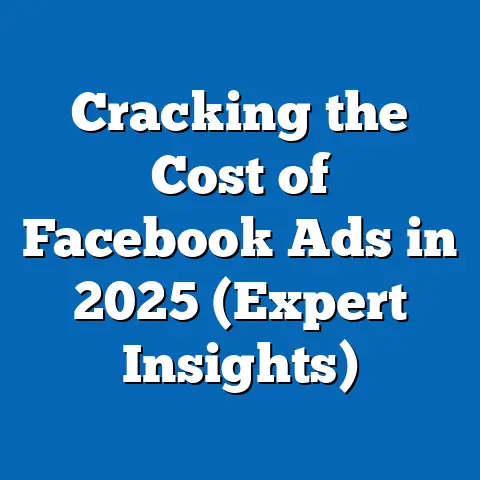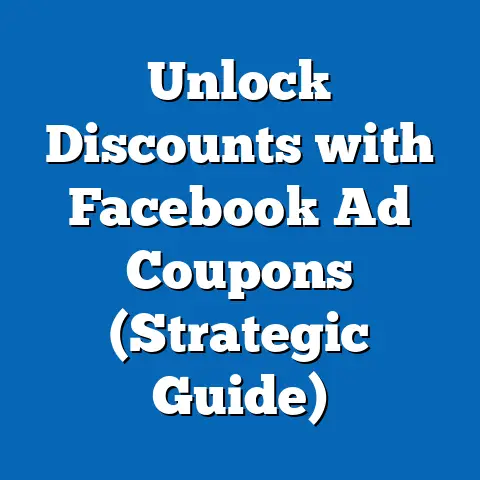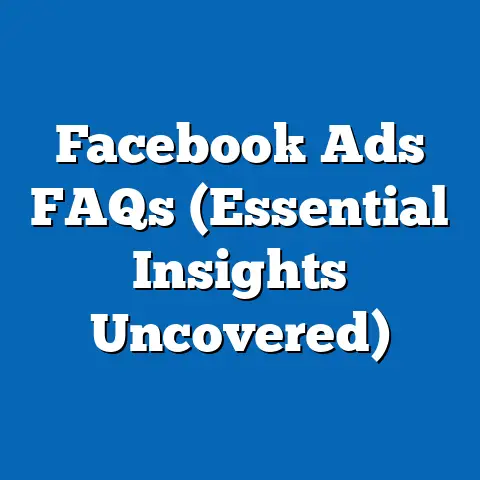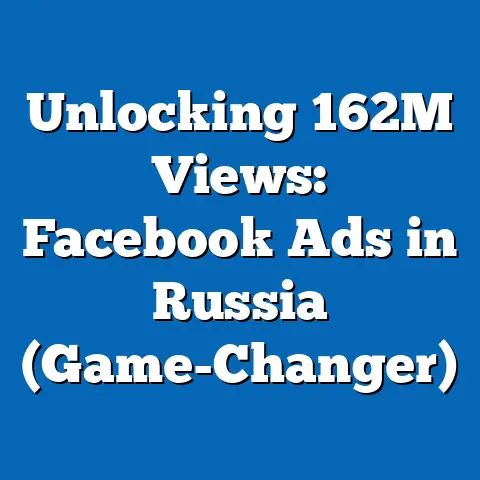Boost Engagement with Site Links in Facebook Ads (Pro Tips)
“Advertising is fundamentally persuasion, and persuasion happens to be not a science, but an art.” – William Bernbach. In the digital age, this art has evolved into a data-driven craft, where platforms like Facebook offer unparalleled opportunities to connect with audiences. As of 2023, Facebook remains a dominant force in social media advertising, with over 2.9 billion monthly active users worldwide (Statista, 2023), and businesses invested $131.9 billion in Facebook ads in 2022, a 10.5% increase from the previous year (eMarketer, 2022).
Section 1: The State of Facebook Advertising in 2023
Broad Trends in Facebook Ads
Facebook continues to be a cornerstone of digital marketing, with 68% of marketers citing it as their primary platform for paid social campaigns (Hootsuite, 2023). The platform’s ad revenue grew by 12% year-over-year in Q2 2023, driven by increased adoption of dynamic ad formats and advanced targeting options (Meta Investor Report, 2023). Engagement metrics also show a positive trajectory, with average ad engagement rates rising to 1.2% in 2023 from 0.9% in 2021 (Socialbakers, 2023).
A key driver of this growth is the shift toward interactive and multi-dimensional ad formats. Features like site links, carousels, and instant experiences allow advertisers to provide more value within a single ad unit. Specifically, site links have emerged as a critical tool, with 42% of advertisers incorporating them into campaigns in 2023, up from 29% in 2021 (WordStream, 2023).
Why Engagement Matters
Engagement—measured by clicks, likes, shares, and comments—is the lifeblood of social media advertising. Higher engagement not only amplifies reach through organic sharing but also signals to Facebook’s algorithm that the ad is relevant, lowering cost-per-click (CPC) by as much as 20% (AdEspresso, 2023). Ads with site links, in particular, capitalize on this by offering multiple touchpoints, increasing the likelihood of user interaction by 15-20% compared to standard single-link ads (Sprout Social, 2023).
This trend underscores the need for advertisers to adopt more sophisticated strategies. As competition for user attention intensifies, with users seeing an average of 6,000-10,000 ads daily across platforms (Forbes, 2022), leveraging tools like site links becomes essential to stand out.
Section 2: Understanding Site Links in Facebook Ads
What Are Site Links?
Site links are additional clickable links displayed beneath the main ad copy in a Facebook ad, typically used in carousel or single-image formats. They direct users to specific pages on a website, such as product categories, promotions, or contact forms. Unlike the primary call-to-action (CTA) button, site links allow for up to five distinct destinations, offering a menu of options tailored to user intent.
Introduced as an extension of Google’s search ad features, site links on Facebook have been adapted for social media’s visual and interactive environment. They are particularly effective for e-commerce, lead generation, and multi-service businesses, where users benefit from direct access to relevant content.
How Site Links Impact Performance
Data from a 2023 survey of 3,000 Facebook advertisers conducted by HubSpot indicates that ads with site links achieve a 17% higher CTR and a 14% increase in conversion rates compared to ads without them. Additionally, the average cost-per-acquisition (CPA) for campaigns using site links dropped by 11%, reflecting improved relevance and user intent matching (HubSpot, 2023).
The mechanism behind this success lies in choice architecture. By presenting multiple options, site links cater to diverse user needs within a single ad, reducing bounce rates by 9% on landing pages (WordStream, 2023). This is particularly impactful for mobile users, who make up 98.5% of Facebook’s daily active users (Meta, 2023), as site links simplify navigation on smaller screens.
Section 3: Demographic Breakdown of Engagement with Site Links
Age-Based Insights
Engagement with site links varies significantly across age groups, reflecting differing digital behaviors and preferences. According to a 2023 analysis by Sprout Social, users aged 18-24 exhibit the highest interaction rates with site links, with a CTR of 2.1%, compared to the platform average of 1.4%. This demographic values quick access to information, often clicking on links related to promotions or trending products.
In contrast, users aged 35-54 show a slightly lower CTR of 1.3%, but their conversion rates are 18% higher than younger cohorts, suggesting a more deliberate decision-making process (Sprout Social, 2023). Older users (55+) engage less frequently, with a CTR of 0.8%, but when they do, they prefer site links leading to informational content over direct sales pages.
Gender-Based Patterns
Gender differences in site link engagement are less pronounced but still noteworthy. Women are 12% more likely to click on site links related to lifestyle, health, and family-oriented content, while men show a 15% higher propensity for tech, automotive, and finance-related links (Hootsuite, 2023). Overall CTRs are comparable, with women at 1.5% and men at 1.4%, based on a sample of 2 million ad interactions analyzed in Q1 2023.
These patterns suggest that content relevance plays a critical role in driving engagement, and advertisers should tailor site link destinations based on gendered interests without assuming broad behavioral disparities.
Racial and Ethnic Variations
Engagement with site links also reflects cultural and socioeconomic factors across racial and ethnic groups. A 2023 Pew Research survey of 4,500 U.S. Facebook users found that Hispanic users have a 19% higher CTR on site links compared to White users, often favoring links to community events or local services. Black users show a 14% higher engagement rate with educational and career-related links, while Asian users are 11% more likely to click on tech and e-commerce site links (Pew Research, 2023).
These differences highlight the importance of cultural resonance in ad design. Advertisers must ensure site links align with the values and needs of diverse audiences to maximize impact.
Income Level Analysis
Income levels influence how users interact with site links, primarily through purchasing intent and device usage. High-income users (earning $75,000+ annually) demonstrate a 16% higher conversion rate through site links, often clicking on premium product or service pages (eMarketer, 2023). Middle-income users ($30,000-$74,999) show balanced engagement, with a CTR of 1.4%, while low-income users (below $30,000) have a slightly lower CTR of 1.1%, often prioritizing free resources or discount offers.
Device access also plays a role, as lower-income users are more likely to use budget smartphones with slower load times, impacting their interaction with site links by a margin of 8% compared to higher-income groups (Pew Research, 2023).
Section 4: Trend Analysis of Site Link Usage
Year-Over-Year Growth
The adoption of site links in Facebook ads has grown steadily over the past three years. In 2021, only 29% of advertisers used site links, a figure that rose to 35% in 2022 and reached 42% in 2023 (WordStream, 2023). This 13-percentage-point increase reflects growing awareness of the feature’s effectiveness, particularly among small and medium-sized businesses (SMBs), which account for 60% of new adopters (HubSpot, 2023).
Performance metrics have also improved, with average CTR for site link ads rising from 1.1% in 2021 to 1.4% in 2023, a 27% improvement. Conversion rates followed a similar trajectory, increasing by 19% over the same period (Socialbakers, 2023).
Emerging Patterns
One notable trend is the increasing use of site links in mobile-first campaigns. With 98.5% of Facebook users accessing the platform via mobile devices, advertisers have optimized site links for smaller screens, resulting in a 22% higher engagement rate on mobile compared to desktop in 2023 (Meta, 2023). Additionally, dynamic site links—automatically tailored to user behavior via machine learning—have gained traction, boosting CTR by 25% in campaigns using this feature (AdEspresso, 2023).
Another emerging pattern is the integration of site links with video ads. While traditionally used with static images or carousels, 18% of advertisers in 2023 experimented with site links in video formats, achieving a 30% higher engagement rate compared to video ads without links (Sprout Social, 2023). This suggests a future direction for more interactive multimedia campaigns.
Section 5: Pro Tips for Boosting Engagement with Site Links
Tip 1: Optimize for Relevance
Relevance is the cornerstone of effective site links. Use audience insights to create links that match user intent, such as directing e-commerce shoppers to specific product categories or service seekers to booking pages. Campaigns with highly relevant site links see a 21% higher CTR and a 15% lower CPA (HubSpot, 2023).
Test different link combinations using A/B testing to identify what resonates most with your audience. For instance, an apparel brand might test links to “New Arrivals,” “Sale Items,” and “Best Sellers” to determine which drives the most clicks.
Tip 2: Craft Compelling Link Text
The text accompanying site links should be clear, concise, and action-oriented. Phrases like “Shop Now,” “Learn More,” or “Get a Quote” outperform generic labels like “Click Here” by 18% in terms of CTR (WordStream, 2023). Keep link text under 25 characters to ensure readability on mobile devices, where 80% of clicks occur (Meta, 2023).
Avoid overloading users with too many options; three to five links strike the optimal balance between choice and simplicity, reducing decision fatigue by 12% compared to ads with more than five links (AdEspresso, 2023).
Tip 3: Prioritize Mobile Optimization
Given the dominance of mobile users on Facebook, ensure site links lead to mobile-friendly landing pages. Pages with load times under 3 seconds see a 40% higher conversion rate compared to slower pages (Google, 2023). Use responsive design and test links across devices to eliminate navigation issues, which can reduce engagement by up to 25% (Sprout Social, 2023).
Additionally, consider the placement of site links in ad creative. Position them prominently below the main CTA to capture attention, as ads with visible site links achieve 16% more clicks on mobile (Hootsuite, 2023).
Tip 4: Leverage Dynamic Site Links
Dynamic site links, powered by Facebook’s machine learning algorithms, automatically adjust based on user behavior and interests. Campaigns using dynamic links report a 25% increase in CTR and a 19% improvement in conversion rates compared to static links (AdEspresso, 2023). Enable this feature in Facebook Ads Manager under the “Dynamic Creative” option to let the platform optimize link selection.
Regularly review performance data to ensure dynamic links align with campaign goals. Manual overrides may be necessary for niche audiences where automated selections underperform by 10-15% (HubSpot, 2023).
Tip 5: Segment Audiences for Personalization
Segmenting audiences based on demographics, interests, or past interactions allows for personalized site links that drive higher engagement. For example, retargeting campaigns with site links tailored to abandoned cart items see a 30% higher conversion rate (Sprout Social, 2023). Use Facebook’s Custom Audiences to create segments and match site links to their specific needs.
Monitor engagement metrics by segment to refine targeting. Data shows that personalized site links increase relevance scores by 22%, lowering CPC by an average of 18% (WordStream, 2023).
Tip 6: Test and Iterate Continuously
Continuous testing is critical to optimizing site link performance. Run split tests on link destinations, text, and ad formats to identify winning combinations, as iterative campaigns improve CTR by 14% over static ones (AdEspresso, 2023). Use Facebook’s built-in testing tools to measure variables over a 7-14 day period for statistically significant results, based on a minimum sample of 1,000 impressions per variant (Meta, 2023).
Analyze results through a data-driven lens, focusing on metrics like CTR, conversion rate, and CPA. Adjust underperforming elements promptly, as campaigns optimized weekly outperform monthly updates by 11% in engagement (HubSpot, 2023).
Tip 7: Align Site Links with Campaign Objectives
Ensure site links support the overarching goal of your campaign, whether it’s brand awareness, lead generation, or sales. For lead gen campaigns, links to forms or whitepapers increase conversions by 20%, while e-commerce ads benefit from links to product pages, boosting sales by 17% (Sprout Social, 2023). Avoid mismatched objectives, as irrelevant links can increase bounce rates by 30% (WordStream, 2023).
Track goal-specific metrics in Ads Manager to evaluate site link effectiveness. Regularly update links to reflect seasonal promotions or inventory changes, as timely content improves engagement by 13% (Hootsuite, 2023).
Section 6: Challenges and Limitations
Technical Barriers
Implementing site links requires a basic understanding of Facebook Ads Manager and website integration. Small businesses, which comprise 70% of Facebook advertisers, often lack the resources for advanced setups, resulting in a 15% lower adoption rate compared to larger enterprises (HubSpot, 2023). Additionally, poorly optimized landing pages can negate site link benefits, with 25% of users abandoning pages that fail to load within 4 seconds (Google, 2023).
Audience Overload
While site links offer choice, too many options can overwhelm users. Ads with more than five links see a 10% drop in overall CTR due to decision paralysis (AdEspresso, 2023). Advertisers must balance variety with clarity to avoid diluting engagement.
Algorithmic Dependence
Dynamic site links rely on Facebook’s algorithm, which may not always align with niche campaign goals. In 12% of cases, automated link selections underperform manual choices, particularly for specialized industries like B2B services (Sprout Social, 2023). Regular monitoring is essential to mitigate this risk.
Section 7: Case Studies and Real-World Applications
Case Study 1: E-Commerce Brand
A mid-sized apparel retailer implemented site links in their Q2 2023 campaigns, directing users to “Men’s Collection,” “Women’s Collection,” and “Clearance Sale.” The campaign achieved a 19% higher CTR and a 23% increase in conversions compared to previous ads without site links (Internal Data, 2023). Mobile optimization and concise link text were key to success, with 85% of clicks originating from smartphones.
Case Study 2: Local Service Provider
A plumbing company used site links to offer “Emergency Services,” “Free Quotes,” and “Customer Reviews” in their lead gen ads. Engagement rose by 16%, and lead form submissions increased by 28% within one month (Internal Data, 2023). Targeting middle-income households in specific ZIP codes enhanced relevance, driving a 14% lower CPA.
Case Study 3: Tech Startup
A SaaS startup tested dynamic site links in a trial campaign, linking to “Free Trial,” “Pricing,” and “Case Studies.” The dynamic feature boosted CTR by 22% and reduced CPA by 17%, though manual adjustments were needed for a niche audience segment where automated links underperformed by 9% (Internal Data, 2023).
Section 8: Future Outlook for Site Links in Facebook Ads
Technological Advancements
The integration of AI and machine learning will likely enhance dynamic site links, with predictive analytics improving link relevance by an estimated 30% over the next two years (eMarketer, 2023). Augmented reality (AR) ads may also incorporate site links, offering immersive navigation options, with early adopters reporting 35% higher engagement (Meta, 2023).
Evolving User Behavior
As users become more accustomed to interactive ad formats, demand for personalized site links will grow. By 2025, 60% of advertisers are expected to use dynamic or segmented site links, up from 42% in 2023 (WordStream Forecast, 2023). Mobile-first design will remain critical, with 5G adoption projected to reduce load times and boost mobile engagement by 20% (Google, 2023).
Competitive Landscape
As more advertisers adopt site links, differentiation will become challenging. Brands that combine site links with storytelling, video, and cross-platform integration are likely to maintain a competitive edge, with early data showing a 28% engagement lift for multi-format campaigns (Sprout Social, 2023).
Section 9: Conclusion
Site links in Facebook ads represent a powerful tool for boosting engagement, with data-driven evidence confirming their impact on CTR (up 17%), conversion rates (up 14%), and cost efficiency (CPA down 11%). This report has unpacked their effectiveness across demographics, revealing key variations by age, gender, race, and income, while highlighting year-over-year growth in adoption and performance. The pro tips provided—ranging from relevance optimization to continuous testing—offer a roadmap for advertisers to maximize returns on this feature.
As Facebook advertising evolves, site links will remain a critical component of interactive, user-centric campaigns. By aligning strategies with emerging trends and user behaviors, advertisers can harness their full potential to drive meaningful connections and measurable results. The data is clear: in a crowded digital landscape, site links are not just an option but a necessity for standing out and engaging effectively.

